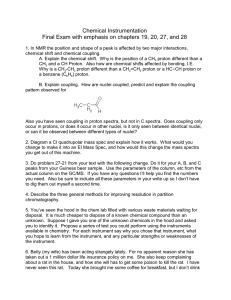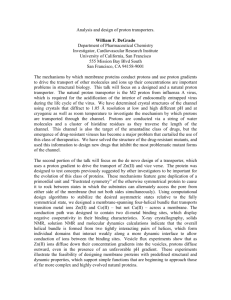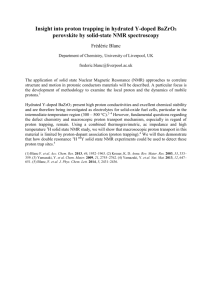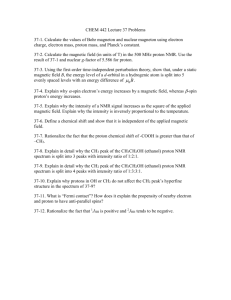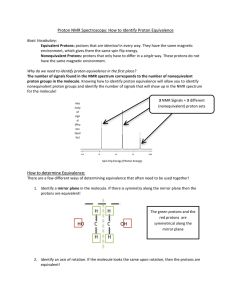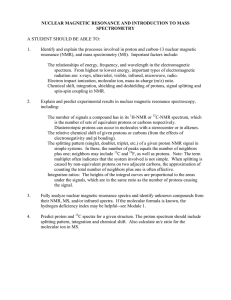Spin-Spin Splitting: Some Complications
advertisement
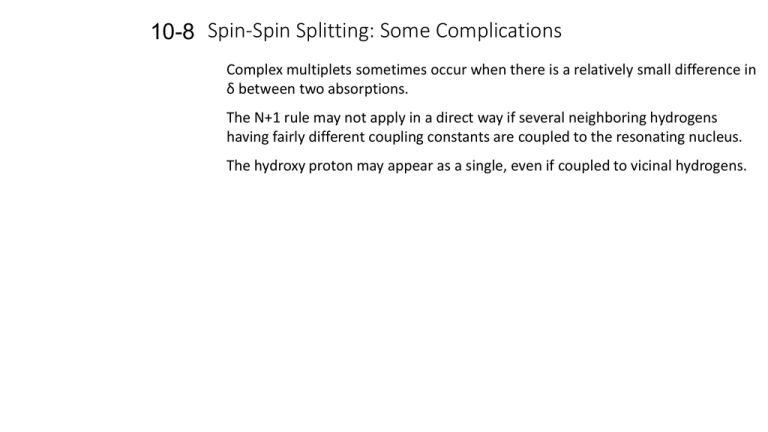
10-8 Spin-Spin Splitting: Some Complications Complex multiplets sometimes occur when there is a relatively small difference in δ between two absorptions. The N+1 rule may not apply in a direct way if several neighboring hydrogens having fairly different coupling constants are coupled to the resonating nucleus. The hydroxy proton may appear as a single, even if coupled to vicinal hydrogens. Close-lying peak patterns may give rise to non-first-order spectra. The intensity patterns in many NMR spectra do not follow the idealized pattern of Pascal’s triangle but instead are skewed towards each other. The intensities of the lines facing each other is slightly larger than expected. Perfectly symmetrical splittings are observed only when the resonant frequency difference of the two groups of protons is much larger than the coupling constant between them. When ν >> J, the spectra is said to be first-order. Non-first-order spectra assume more complex shapes and can only be analyzed with the help of computers. Since the resonant frequency difference increases with higher field strengths (J remains the same), a complicated spectrum can be made first order by measuring it at higher field strengths. Coupling to non-equivalent neighbors may modify the simple N+1 rule. The spectrum of 1,1,2-trichloropropane illustrates the effects of two sets of nonequivalent neighbors. The Ha proton is split by the Hb proton into a doublet as expected. This doublet is at low field due to the effect of two adjacent chlorine atoms. The methyl protons are also split by the Hb proton into a doublet as expected. This doublet is at high field. The Hb proton is split by both Ha and the methyl protons. In this case eight lines are observed because Ha and the methyl protons have different coupling constants to Hb. The methyl group splits the Hb resonance into a quartet (1,3,3,1). Each line of the quartet is then split into a doublet by the Ha proton (1,1,3,3,3,3,1,1). In the case of 1-bromopropane, the hydrogens on C2 are also coupled to two nonequivalent sets of neighbors. A theoretical analysis of this resonance would predict as many as 12 lines (a quartet of triplets). Because the coupling constants are very similar, however, many of the lines overlap, thus simplifying the pattern. Fast proton exchange decouples hydroxy hydrogens. In the spectra of 2,2-dimethyl-apropanol, the OH absorption appears as a single peak and is not split by the CH2 protons. In addition, the CH2 protons are not split by the OH. The OH proton is weakly acidic and is both between alcohol molecules and traces of water on the NMR time scale at room temperature. This type of decoupling is called “fast proton exchange.” It may be slowed or removed by removal of traces of water or acid or by cooling. Rapid magnetic exchange self-decouples chlorine, bromine, and iodine nuclei. Fluorine is the only halogen that exhibits spin-spin coupling to 1H in a proton NMR spectra. Chlorine, bromine, and iodine exhibit a fast internal magnetic equilibration on the NMR time scale which precludes an adjacent proton from recognizing them as having different alignments in the external field. This is termed “self-decoupling,” in contrast to exchange-decoupling, as exhibited by the hydroxy protons.
